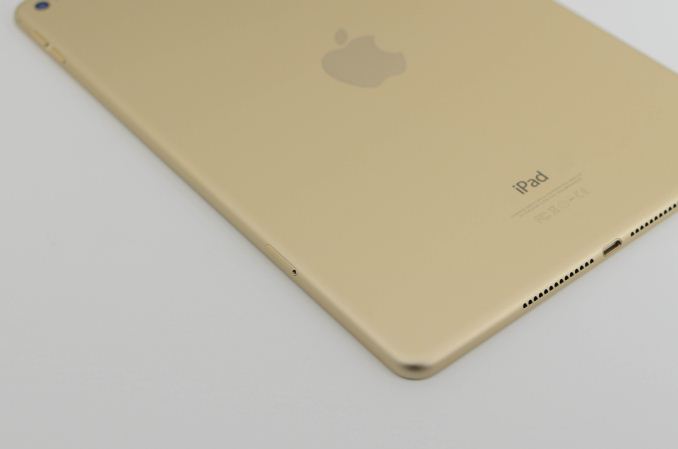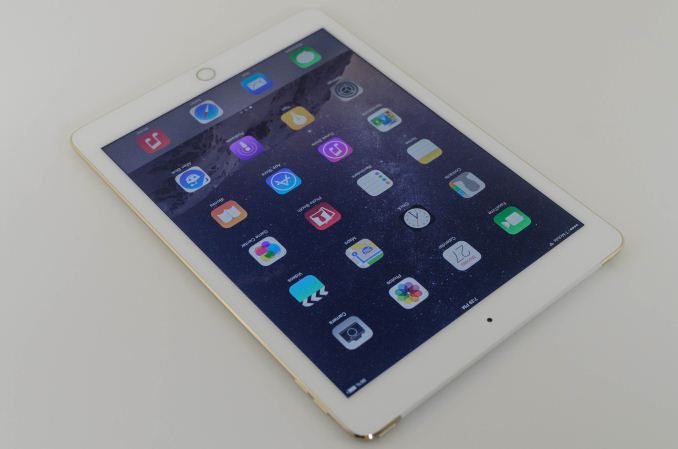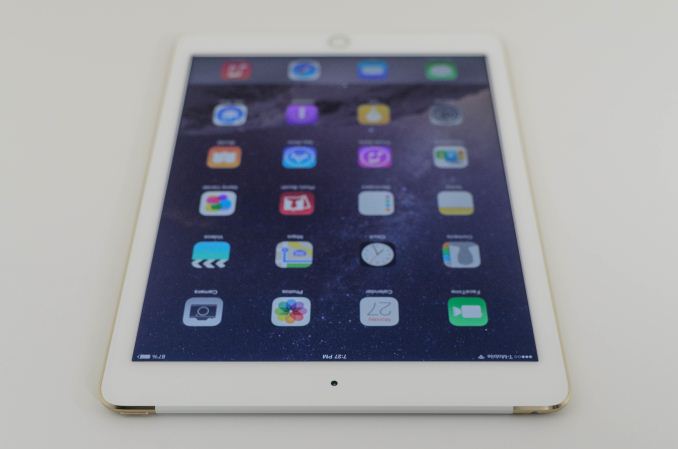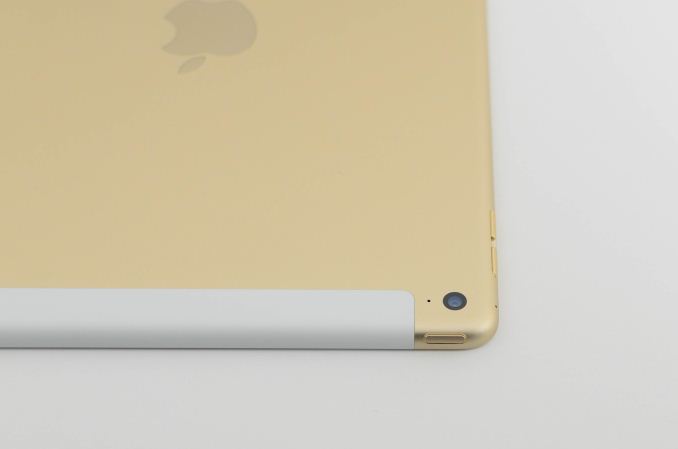The Apple iPad Air 2 Review
by Joshua Ho on November 7, 2014 9:30 AM EST- Posted in
- Tablets
- Apple
- Mobile
- iOS
- ipad Air 2
Final Words
Overall, there’s a lot to go over on the iPad Air 2. While the name suggests that it’s an iterative update in nature, in practice these updates add a lot of compelling hardware to the high-end iPad line. One of the first areas worth looking at here is the design. While not a radical shift from the iPad Air, the differences in design and the even thinner build helps to set the iPad Air 2 apart.
The next item of note is the A8X, which represents a return to dedicated SoCs for the iPad line. This is presumably done to preserve performance parity at native resolution for the iPhone and iPad line, and the extra CPU core is intriguing as it represents a shift away from the two CPU core system that Apple has stuck with for a while. In practice, this makes the iPad Air 2 one of the fastest ARM-based tablets on the market. Only NVIDIA’s Tegra K1 is able to compete with its GPU performance, and at the cost of greater heat and power consumption.
The next major point of note is the display. While not much has changed to the display itself, the surrounding components have seen a few upgrades that have been sorely needed for the past few years. The display is now laminated to the cover lens, which dramatically improves interactions with the device as the display feels much closer to the glass than before. The iPad Air 2 also has a custom anti-reflective coating on the display is really unlike anything else I’ve seen before as the frequencies reflected make the glass appear to be producing purple reflections. Despite keeping the tablet at 200 nits, I found that it was still fully possible to read the display outdoors during the day. There also seems to be some level of improved calibration, although the panel is mostly the same when judged by the appearance of the gamut and also the brightness/contrast numbers. At any rate, this display is more than capable of doing proper photo editing as the device is more than accurate enough for serious work.
Despite these upgrades and the smaller battery, in practice it seems that Apple has made good on their promise of generally unchanged battery life from the iPad Air. While there are phones and phablets out there with better battery life, I suspect that most will be more than happy with the battery life of the iPad Air 2. If one found battery life to be sufficient on a previous iPad, battery life on the iPad Air 2 should just be more of the same rather than any surprises. Apple also deserves some level of recognition for the incredible efficiency and sustained performance during this test as even the Tegra K1 can't quite do both.
There’s also the question of software, which continues to be class-leading on the iPad. While tablet applications that haven’t been properly scaled on the iPhone line are likely to look horrible due to the scaling factor used, this kind of experience is unlikely to occur due to the strength of the ecosystem at this point. While the same can and does happen with Android apps, it isn’t nearly as obvious because most of the scaling done is far more seamless and simply leaves a great deal of white space in the application that can’t necessarily be used.
As a result of all this work, it seems pretty obvious that the iPad Air 2 continues to deliver some of the best tablet software on the market. For the most part, every application available seems to effectively deliver a tablet-specific experience that helps to set the iPad lineup apart from other tablets. Unfortunately, it seems that due to a lack of competition there isn’t much in the way of attempts to dramatically improve the software experience, and as a result it’s a bit difficult for me to justify carrying a tablet around all the time as its size means I can't just put it in a pocket unlike a six-inch phablet.
However, there are still some notable new features, namely TouchID, which works incredibly well and leverages Apple’s tightly-meshed ecosystem to deliver a better experience than just about anything else on the market. Unfortunately, I’m not necessarily sold on TouchID on a tablet as an ergonomic ideal as the sheer width of the device makes it a bit harder than usual to properly place my finger for scanning. The functionality makes up for it though and TouchID remains one of the real killer features of Apple devices.
Finally, the camera is a nice step up from the iPad Air. While it may seem like an incremental step, a meaningful camera change to the iPad Air 2 is relatively surprising given that it hasn’t significantly changed since the iPad 3. It’s surprisingly competent in daytime, although at night a great deal more noise creeps in than one might expect from an iPhone 6 or similar device which has a larger sensor.
Overall, the iPad Air 2 is likely to be one of the only tablets worth buying on the market today. While iOS isn’t perfect, it’s definitely delivering the best tablet experience as its app support is second to none. While other OEMs may have more features, iOS manages to hold on by virtue of its superior polish and integration with Apple hardware. While I’d like to see Apple push the envelope further with the iPad line, it’s hard to argue this when other OEMs seem to be content with the status quo. While it’s likely that Apple will be able to hold on to its tablet lead, it remains to be seen if Google’s Nexus 9 can prove to be a viable competitor to the iPad Air 2.














226 Comments
View All Comments
DosOldie - Sunday, November 9, 2014 - link
I still have an iPad 2 and I do not plan on upgrading my iPad until there is add on space. Put in a usable SD slot and I' ll upgrade. Adding & deleting apps will not change w a new iPad w the same amt of space.ws3 - Wednesday, November 12, 2014 - link
So you will never be upgrading...tralalalalalala40 - Thursday, November 13, 2014 - link
See the iStick... You see. everything is going wireless. They have wireless HDs from toshiba that are for the iPad now. You don't need a random dust collecting/battery dwindling port to get done what you want to get done.sdagley - Monday, November 10, 2014 - link
The line "I’m not necessarily sold on TouchID on a tablet as an ergonomic ideal as the sheer width of the device makes it a bit harder than usual to properly place my finger for scanning" in the Final Words section doesn't make sense. The TouchID sensor works with multiple fingers at any any orientation which makes it easy to use no matter how you're holding it. This review makes it sound like Apple uses the old style vertical swipe sensor like the Galaxy S5 usesLgFriess - Monday, November 10, 2014 - link
Just picked up an Air 2 over the weekend. I'm no Apple fan boy (PC gamer, Note 3 phone and don't think I'll ever go back to an iphone, and I generally despise itunes) , I just wanted what I thought would work best for me. After agonizing for months over every tablet out there including the Nexus 9, I just liked the Air 2.The cons (since that's what everybody seems interested in);
1. It's almost too thin. It feels delicate to me. I'd much rather have a bit thicker tablet with a more substantial feel. Stop with the thin thin thinner crap. Of course I have a case on the way but still.
2. The vibration. Yep it's definitely there. However, I can't think of any situation that this would bother me in the least bit. I wouldn't have thought to mention it but I saw so many comments here saying it's worse then ebola. There is no way somebodies fingers are going numb when holding it. People are starting to make up things to enforce their argument. The vibration certainly goes back to problem 1. Too thin, too light, too delicate in the hand.
3. Speakers. Not that I'm expecting anything great on a tablet but I sure like the thought of the Nexus front facing speakers. It's just a better solution. The ipad speakers aren't bad at all. They're just typical tablet speakers.
All in all, it's been a great addition. Fast, smooth, great apps (just tried Hearthstone for the first time, and as a PC gamer, I'd say it makes a great tablet game which I generally can't stand), display is gorgeous, battery life is longer then expected though gaming will eat it up quickly. The fingerprint ID thing IS nice, which surprises me as I wouldn't have thought I would care.
Very happy with my purchase.
LgFriess - Monday, November 10, 2014 - link
One other thing. There is absolutely NO distortion just holding the tablet. Another instance of over dramatization. I've put a little pressure into the back and didn't notice any distortion in that case either, but as I've said above, I do feel it's too thin/delicate and I'm afraid I'll damage it if I were to squeeze it too much. By "too much" I mean actively trying to bend it to see if the screen will distort, but not under normal use.tralalalalalala40 - Thursday, November 13, 2014 - link
When I pile-drive my LCD monitors at work they distort so I took them back.yhselp - Monday, November 10, 2014 - link
It's worth mentioning that this is the first handheld device (apart from full-fledged Windows tablets) truly close to last-gen gaming consoles in terms of performance - 25.6 GB/s memory bandwidth and a powerful triple-core CPU. It'd be interesting to see how the 1.5 GHz enhanced Cyclone stacks against the 3.2 GHz PowerPC in the Xbox 360.spammy39 - Tuesday, November 11, 2014 - link
Is there any reason why Anandtech does not include the Surface Pro 3 on the benchmark list?Fairshare - Wednesday, November 12, 2014 - link
Do you see any Intel Core based tablets here? The Surface Pro 3 is a PC that just happens to be a tablet so it's not really comparable in terms of performance. You might compare other statistics such as battery, display etc. but it's otherwise a completely different animal.